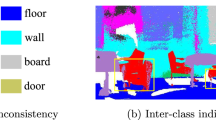Abstract
When performing processing tasks such as semantic segmentation on point cloud data, one of the biggest challenges is how to effectively capture both the local details as well as the long-range dependencies in the data. Existing processing methods often struggle to deal with both types of information simultaneously, which leads to limited performance when processing complex scenarios. To address this problem, this paper proposes a dynamic graph attention network DGAT-net. First, a dynamic graph is constructed using a feature similarity and spatial relationship-based approach to capture the local structure and long-range semantic dependencies in point cloud data. Dynamic edge sampling is also added to update the dynamic graph to reduce computational complexity. A spatial self-attention mechanism and a graph attention mechanism are introduced to capture local detail information and global dependencies, respectively, to further enhance the model’s ability to understand complex spatial relationships. Moreover, the fusion of these two attention mechanisms combined with the gating mechanism are dynamically selected to adapt to different data characteristics and task requirements. Experimental results on public point cloud datasets show that our method achieves superior performance in semantic segmentation tasks, validating its effectiveness and practicality.
Access this chapter
Tax calculation will be finalised at checkout
Purchases are for personal use only
Similar content being viewed by others
References
Armeni, I., et al.: 3D semantic parsing of large-scale indoor spaces. In: Proceedings of the IEEE Conference on Computer Vision and Pattern Recognition, pp. 1534–1543 (2016)
Behley, J., et al.: Se-mantickitti: a dataset for semantic scene understanding of lidar sequences. In: Proceedingsof the IEEE/CVF International Conference on Computer Vision, pp. 9297–9307 (2019)
Chen, Y., Dai, X., Liu, M., Chen, D., Yuan, L., Liu, Z.: Dynamic convolution: attention overconvolution kernels. In: Proceedings of the IEEE/CVF Conference on Computer Vision and Pattern Recognition, pp. 11030–11039 (2020)
Du, Z., Ye, H., Cao, F.: A novel local-global graph convolutional method for point cloud semantic segmentation. IEEE Trans. Neural Netw. Learn. Syst. 35(4), 4798–4812 (2022)
Hong, J., Kim, K., Lee, H.: Faster dynamic graph CNN: faster deep learning on 3D point cloud data. IEEE Access 8, 190529–190538 (2020)
Hu, Q., et al.: Randla-net: efficient semantic segmentation of large-scale point clouds. In: Proceedings of theIEEE/CVF Conference on Computer Vision and Pattern Recognition, pp. 11108–11117 (2020)
Jing, W., Zhang, W., Li, L., Di, D., Chen, G., Wang, J.: Agnet: an attention-based graph network for point cloud classification and segmentation. Remote Sens. 14(4), 1036 (2022)
Landrieu, L., Simonovsky, M.: Large-scale point cloud semantic segmentation with super-point graphs. In: Proceedings of the IEEE Conference on Computer Vision and Pattern Recognition, pp. 4558–4567 (2018)
Lu, D., Zhou, J., Gao, K.Y., Du, J., Xu, L., Li, J.: Dynamic clustering transformer network for point cloud segmentation. Int. J. Appl. Earth Obs. Geoinf. 128, 103791 (2024)
Milioto, A., Vizzo, I., Behley, J., Stachniss, C.: Rangenet++: fast and accurate lidar semanticsegmentation. In: 2019 IEEE/RSJ International Conference on Intelligent Robots and Systems (IROS), pp. 4213–4220. IEEE (2019)
Ngo, T.D., Hua, B.S., Nguyen, K.: Isbnet: a 3D point cloud instance segmentation network with instance-aware sampling and box-aware dynamic convolution. In: Proceedings ofthe IEEE/CVF Conference on Computer Vision and Pattern Recognition, pp. 13550–13559 (2023)
Qi, C.R., Yi, L., Su, H., Guibas, L.J.: Pointnet++: deep hierarchical feature learning on pointsets in a metric space (2017)
Redmon, J., Farhadi, A.: Yolov3: an incremental improvement. arXiv preprintarXiv:1804.02767 (2018)
Shuai, H., Xu, X., Liu, Q.: Backward attentive fusing network with local aggregation classifier for 3D point cloud semantic segmentation. IEEE Trans. Image Process. 30, 4973–4984 (2021)
Tatarchenko, M., Park, J., Koltun, V., Zhou, Q.Y.: Tangent convolutions for dense predictionin 3D. In: Proceedings of the IEEE Conference on Computer Vision and Pattern Recognition, pp. 3887–3896 (2018)
Tian, Z., Shen, C., Chen, H.: Conditional convolutions for instance segmentation. In: Vedaldi, A., Bischof, H., Brox, T., Frahm, J.-M. (eds.) ECCV 2020. LNCS, vol. 12346, pp. 282–298. Springer, Cham (2020). https://doi.org/10.1007/978-3-030-58452-8_17
Wang, Y., Sun, Y., Liu, Z., Sarma, S.E., Bronstein, M.M., Solomon, J.M.: Dynamic graph CNN for learning on point clouds. ACM Trans. Graph. (TOG) 38(5), 1–12 (2019)
Wu, W., Qi, Z., Fuxin, L.: Pointconv: deep convolutional networks on 3D point clouds. In: Proceedings of the IEEE/CVF Conference on Computer Vision and Pattern Recognition, pp. 9621–9630 (2019)
Zhai, Z., Zhang, X., Yao, L.: Multi-scale dynamic graph convolution network for point clouds classification. IEEE Access 8, 65591–65598 (2020)
Zhang, K., et al.: Linked dynamicgraph CNN: learning through point cloud by linking hierarchical features. In: 2021 27th International Conference on Mechatronics and Machine Vision in Practice (M2VIP), pp. 7–12. IEEE (2021)
Zhang, Y., et al.: Polarnet: an improvedgrid representation for online lidar point clouds semantic segmentation. In: Proceedings of the IEEE/CVF Conference on Computer Vision and Pattern Recognition, pp. 9601–9610 (2020)
Author information
Authors and Affiliations
Corresponding author
Editor information
Editors and Affiliations
Rights and permissions
Copyright information
© 2024 The Author(s), under exclusive license to Springer Nature Singapore Pte Ltd.
About this paper
Cite this paper
Miao, Y., Yi, X., Guan, N., Lu, H. (2024). DGAT-net: Dynamic Graph Attention for 3D Point Cloud Semantic Segmentation. In: Huang, DS., Pan, Y., Zhang, Q. (eds) Advanced Intelligent Computing Technology and Applications. ICIC 2024. Lecture Notes in Computer Science, vol 14872. Springer, Singapore. https://doi.org/10.1007/978-981-97-5612-4_22
Download citation
DOI: https://doi.org/10.1007/978-981-97-5612-4_22
Published:
Publisher Name: Springer, Singapore
Print ISBN: 978-981-97-5611-7
Online ISBN: 978-981-97-5612-4
eBook Packages: Computer ScienceComputer Science (R0)




